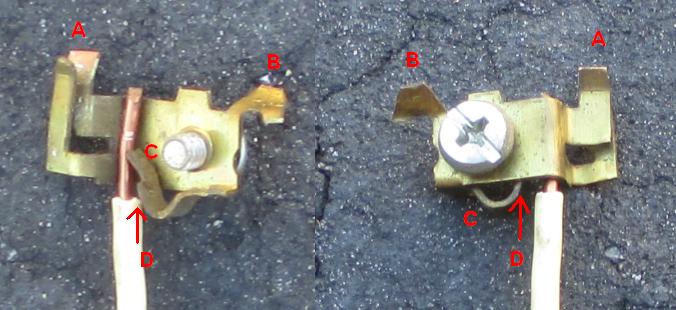
Push-In Quick-Connect Wiring
Most 15 ampere receptacles and switches and similar devices for home wiring allow connections to be made by simply pushing the wire end into a hole in the back of the device and the wire stays in place.
Most electricians wiring up new construction use these push-in, or backstab, connections because these connections can be made in much less time.
This connection does meet code (National Electric Code) and is approved by various safety rating agents such as Underwriters Laboratories. But some experts say that the connection is less reliable than using the screw terminals to attach the wires.

We dissected an old receptacle to expose the push-in (backstab) connection. As can be seen, the wire is held in contact with the inner metal framework by a springy tongue. Yes, the layman might think of it as being flimsy.

A -- Clip behind prong slot that makes contact with the plug prong.
B -- Tab between the two screws on one side of a duplex receptacle that can be bent back and forth and snapped off to allow the two halves of the receptacle unit to be wired separately.
C -- Springy tongue that holds wire in place.
D -- Inserting a small screwdriver blade into a hole contacts the tongue here to release the wire end from the receptacle. (Care must be used otherwise the tongue can be deformed so as to not hold another wire in place.)
In reality, the wire end contacts the metal framework only in a few places because it is impossible to shape it precisely enough to conform to the surface of the framework. (The tongue counts as a contact point.) Whereas using the screw terminals gives a larger contact area with both the metal framework and the head of the screw. The smaller the contact area and the larger the number of amperes being drawn, the more heat is generated at that spot and the connection can deteriorate more rapidly.
There is a different style of receptacle (not pictured) where the wire is inserted into a hole in back and held between two small plates by tightening a screw on the outside. This gives a tighter connection than is pictured above. Some electricians refer to this type of connection as "back-wire" to distinguish it from the backstab connections referred to earlier.
Last updated 10/2/13
Go to other, unrelated, topics
All parts (c) copyright 2010, Allan W. Jayne, Jr. unless otherwise noted or other origin stated.
If you would like to contribute an idea for our web pages, please send us an e-mail. Sorry, but due to the volume of e-mail we cannot reply personally to all inquiries.